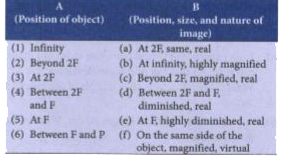Derive lens maker's formula for a thin convex lens.
Basic assumptions in derivtion of Lens - maker's formula:
(i) Aperture of lens should be small
(ii) Lenses should be thin
(iii) Object should be point sized and placed on principal axis.

Suppose we have a thin lens of material of refractive index n2, placed in a medium of refractive index n1, let o be a point object placed on principle axis then for refraction at surface ABC we get image at I1
∴n2V1,n1v=n2−n1R1......(1) But the refracted ray before goes to meet at I1 falls on surface ADC and refracts at I2
finally, hence I1 works as a virtual object 2nd refracting surface
∴n1V−n2V1=n1−n2R2.....(2)
Equation (1) + (2)
n1V−n1u=(n2−n1)(1R1−1R2)
∴1V−1u=(n21−1)(1R1−1R2)........(3)
Ifu=∞,v=f
1f=(n21−1)(1R1−1R2)........(4)
Which is lens maker's formula.
Topper's Solved these Questions
- SAMPLE PAPER 2019BOOK - XII BOARDS PREVIOUS YEARCHAPTER - SAMPLE PAPER 2019EXERCISE - SECTION D
6 Videos
- SAMPLE PAPER 2019BOOK - XII BOARDS PREVIOUS YEARCHAPTER - SAMPLE PAPER 2019EXERCISE - SECTION B
9 Videos
- QUESTION PAPER 2023BOOK - XII BOARDS PREVIOUS YEARCHAPTER - QUESTION PAPER 2023EXERCISE - Question
43 Videos
- XII BOARDSBOOK - XII BOARDS PREVIOUS YEARCHAPTER - XII BOARDSEXERCISE - SECTION - B
9 Videos
Similar Questions
Knowledge Check
A convex lens
AIs thicker at the middle than at the edgesBis thicker at the edges than at the middleChas uniform thickness everywhereDis called a diverging lensLens maker's formula is applicable to
AThin lenses and paraxial rays which subtend very small angles with the principal axisBThick lenses and paraxial rays which subtend very small angels with the principles axisCThin lenses and for marginal raysDThick lenses and for marginal rays
(a) Derive lens maker's formula for a biconvex lens. (b) A point object is placed at a distance of 12 cm on the principal axis of a convex lens of focal length 10 cm. A convex mirror is placed coaxially on the other side of the lens at a distance of 10 cm. If the final image coincides with the object, sketch the ray diagram and find the focal length of the convex mirror.
View SolutionDerive lens formula for a concave lens.
View SolutionImage formation by a convex lens

View SolutionUsing lens maker's formula, derive the thin less formula 1f=1v−1u for a biconevex lens.
View SolutionWrite the basic assumptions used in the derivation of lens- maker's formula and hence derive this expression.
View SolutionUsing lens maker's formula, show how the focal length of a given lens depends upon the colour of light incident on it.
View Solution
